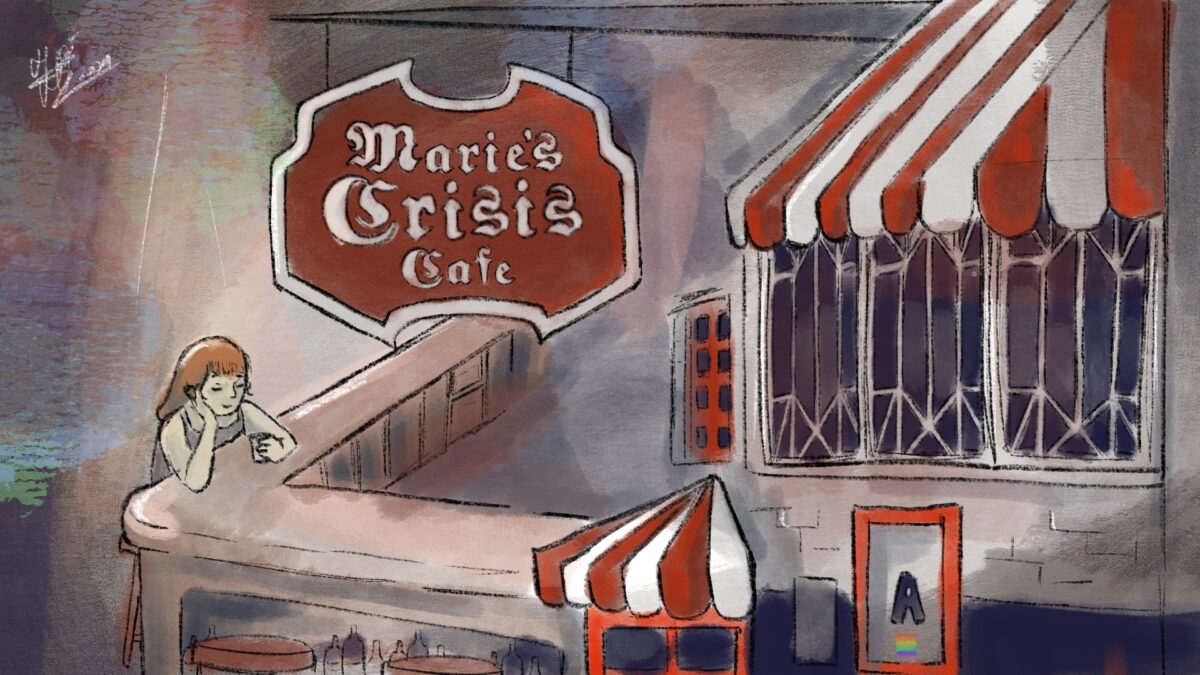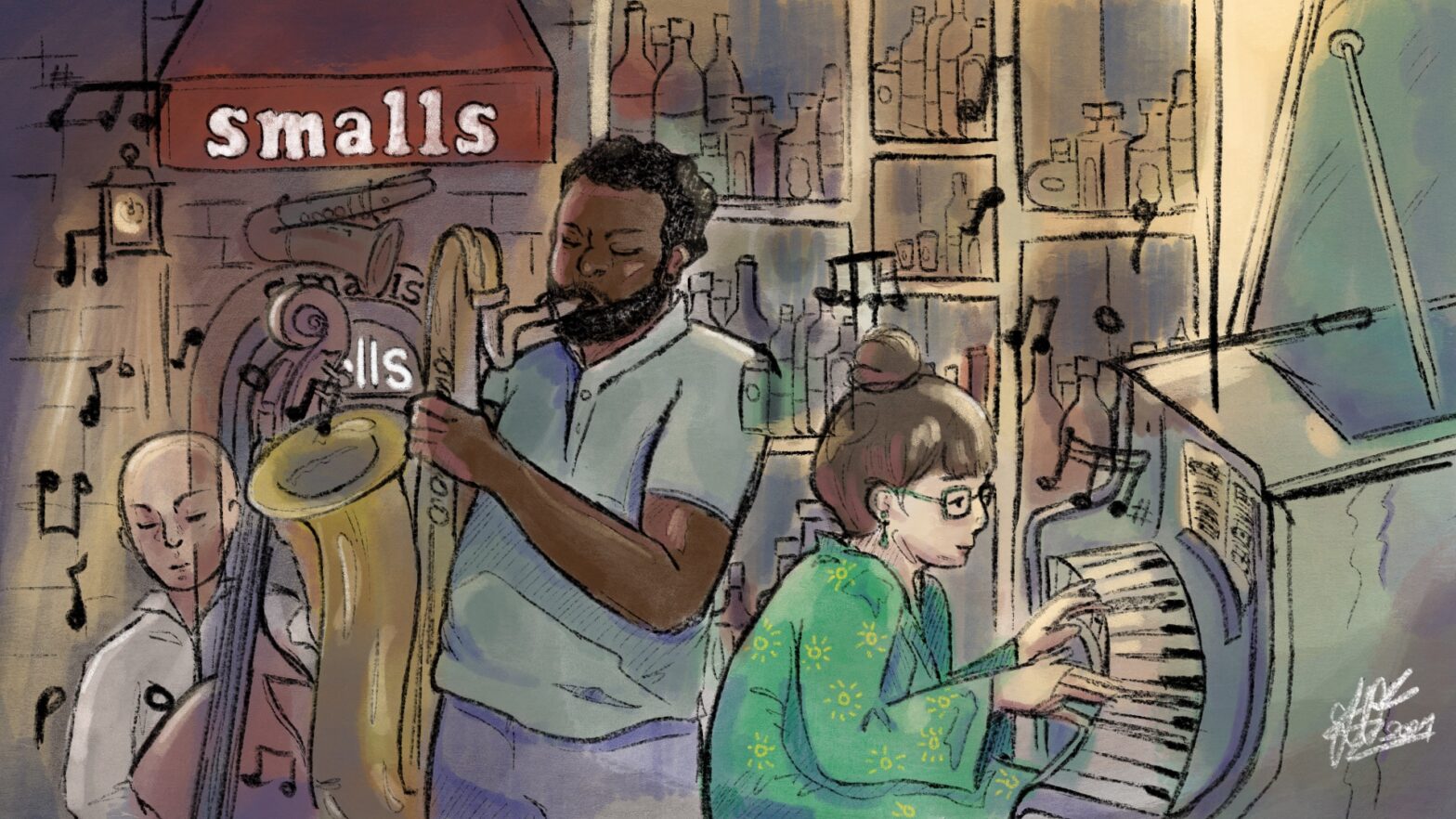This series is published under a pseudonym in order to preserve the nonjudgmental atmosphere of college nightlife and focus on the overall experience of the location(s) described.
Welcome to Nightcap Notes — a monthly exploration of hidden gems, old favorites, and headaches to avoid at night in New York City. This week we visit Smalls Jazz Club (183 West 10th St.) and step in for a drink at Marie’s Crisis Cafe (59 Grove St.).
Hello my fellow insomniacs and intrepid adventurers,
As the semester wears on and the frigidity in the air begins to dissipate, don a spring coat and possibly a scarf as you travel over to Greenwich Village. Look for the saxophone above the door and descend the steps into Smalls Jazz Club, forgetting your looming deadlines and becoming one with the city’s jazz scene.
On a gloomy Sunday night around 11:20 p.m., this caffeinated writer took a walk through the Village to see the 12 a.m. jazz set — passing closed restaurants, empty bars, and sidewalks devoid of people. If your trek takes you to the neighborhood early and you’re feeling peckish, be warned that most places close at midnight and are priced for the working professional crowd’s paycheck. However, if you’re concerned the growling in your stomach might overshadow the jazz and are in the mood for a pre-show slice, head over to the West Village location of Village Square Pizza for a top-tier meal and some delicious garlic knots.
In order to get a good seat at Smalls Jazz Club, arrive 30 minutes before the show. If you can rally the night owls in your life try to attend the 12 a.m. sets Sunday-Thursday where students pay $10 when they buy tickets at the door. Keep in mind there is a one drink minimum cover charge until the 1 a.m. jam.
Release any anxieties you might have about the exclusivity of jazz culture and enter into the warmly lit, brick-walled basement covered in images of jazz musicians. Despite the small space, there’s an abundance of comfortable places to sit. The first stop? A seat with a good view of the stage. If you’re looking for the best place to have an intimate conversation and space to get comfortable with your group — if space even exists in New York City — snag a spot at the corner benches parallel to the bar on the left-hand side of the room.
You can order at the bar, but since they provide table service, settle in with a full menu of cocktails, wine, beers, spirits, and non-alcoholic options, as well as two snack choices: assorted Greek olives and mixed nuts.
My party got a margarita, whiskey sour, and Stella. While the drinks aren’t cheap (most being in the mid to upper $10 range), considering you have to buy at least one, they weren’t bad either. But be warned that they are serious about their citrus. If the itch for caffeine is calling, they also have drip coffee and the arguably better option — Irish coffee. The staff is more than happy to answer any questions about the menu and will check in with you throughout the night, but there’s no pressure to order more.
Smalls first opened in 1994, closed briefly in 2001, and reopened its doors in the mid-2000s. Originally founded with the goal of creating a place for jazz artists and fans alike to appreciate music and socialize, it has endured multiple transitions in ownership and managed to survive the COVID-19 pandemic due to its loyal fan base. Once you watch a show, it’s easy to see why the homey space and quirky patrons have encouraged a broad range of musicians at various points in their careers to play there.
The night we went it wasn’t packed, and the crowd was a bit older (30+), but conversations were rife and as more people trickled in, I got the sense they’d all been there together before. Our musicians for the night were the Nick Hempton Quartet made up of an alto sax, guitar, organ, and drums. We watched their second set and as the music began to play you could tell that the show was going to be good. The set was an eclectic blend of smooth, fast, romantic, and slow music, and on multiple occasions the musicians took turns playing long solos when the band and the crowd would sway and groove in their seats.
In between songs, band leader and sax player Nick Hempton engaged the audience with jokes about hanky-panky and love while taking the occasional sip of beer. Some people took moments to film and photograph the show, but this writer wouldn’t advise it. If you’d like a photo for Instagram, take one quickly or outside the door and then tuck your device away — the rest of the audience will appreciate it.
Speaking of the audience, don’t be shy! People there are more than willing to talk about the music and their philosophies on life when given the chance. I struck up a long conversation with a jazz guitarist from Canada about the intangible magic of our great city. Fellow patrons gave my friends and I recommendations for four other jazz spots to check out… stay tuned. If you’re a newbie to the scene, expect to be confused in the moment by some of the audience’s insights on the show but leave at the end of the night feeling like you’re a jazz expert.
The set wraps up around 1 a.m., and then any musicians are welcome to come up for an informal jam session. As more people descended the steps to join the jam, the first brave soul sang a slow tune to a piano accompaniment, which was a nice palate cleanser from the instrumental set. My group stayed for about 30 minutes — the jam lasts until 3 a.m. every night — before deciding that another (less expensive) drink was in order.
Grab your bags, button up those coats, and take a two-minute trek over to a West Village institution: Marie’s Crisis Cafe. I’d walked by earlier in the evening when there was a group of people waiting outside to go in, so we had hopes for an eclectic bunch of characters. But upon arrival, we realized we had been a bit optimistic given the time of night.

In the early morning darkness, Marie’s Crisis Cafe’s big red sign and white, red, and black decorated exterior is unmissable (even if the line was lacking). As a Broadway show tunes sing-along piano bar, the spot is a unique excuse to have a drink and conduct some drunken musical theater where they advertise that anyone, provided they are 21, is welcome.
Marie’s feeling of inclusivity can be traced back to its fascinating history: the building has existed since 1839. It was a brothel and boarding house before becoming a quasi-restaurant and speakeasy in 1929 acting as a safe space for the gay community in New York. They no longer serve food, and your drink options are limited to beer, wine, and basic vodka soda-type concoctions, but our bartender for the night, Joseph O’Neill, was full of charm. There’s no cover to enter the establishment but a purchase of two drinks is required. Keep in mind they only accept cash.
When we got there, a small group of people were singing around the Sunday night pianist, Dan Daly, but the rest of the place was empty which was quite pleasant for a cackling catch-up on the night. If you’ve ever watched “Friends,” or any spatially unrealistic New York City sitcom, I can only describe sitting in an empty bar of that size like inheriting a grandmother’s rent-controlled apartment: it seems impossible, but when it does happen you never want to leave. If you do stay until closing, enjoy the silence on your meditative walk to the subway, and from personal experience, I sincerely wish you luck waking up on time for classes the next day.
Till the next night. . .








Leave a Reply